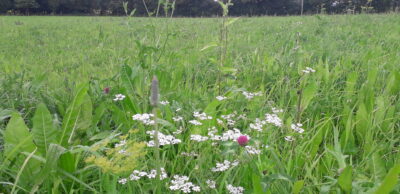Multi-Species Grassland
Overview
Presently, most grass swards are dominated by perennial ryegrass with perhaps some clover. With just two plant species in a mix, the modern grass sward is lower in species of insects and other invertebrates than grass swards in the past. The BRIDE Project Multi-Species Grassland mix contains several grass species including Timothy, Cocksfoot, Fescues, and several wildflower species such as Plantain, Red and White clover and Yarrow to benefit pollinators and a wide range of other insects.

Creation
The multi-species grassland mix can be sown in any field but for attracting species such as Skylark, several other factors need to be considered before works begin. These include the aspect, soil type (wet or dry), elevation and surrounding landscape. The ecologist will advise on the best location for this habitat. This involves the planting of 1 ha of a multi-species grass seed and wildflower mix (see page 43 of BRIDE Project – Farm Habitat Management Guidelines) that will resemble the pastures that have been lost to modern farming intensification. This can be done in the conventional way by ploughing, harrowing and seeding or through stitching-in without tilling.
Management
Correct management of the multi-species grassland sward is essential to ensure its success. Do not apply sprays, as these will kill the herb species. These swards will naturally keep weeds from establishing. The sward should receive little fertiliser as this will benefit the more aggressive species leading to the herb species being out-competed. The clover in the sward will fix nitrogen and the low nutrient level will benefit the restoration of wildflowers back into the sward. The most challenging management measure will be the stocking rate. The aim is to have a low stocking rate and a longer rotation than the conventional 21 days. This will allow various plant species to grow and seed and will also facilitate the development of a tussocky sward structure that is more beneficial to biodiversity improvement. Cutting or topping the sward will lead to a sub-standard habitat.
Benefits
This multi-species mix will provide the specific sward structure that is required by some of our threatened farmland birds. The mix contains clover which can fix nitrogen thus reducing the need for artificial fertiliser. Plantain and Yarrow add to the diversity of the sward and can contribute to the health of grazing livestock. These are deep rooted plants which can also add to the different nutrient value of the sward for livestock. The inclusion of six species of grass instead of the normal single species will give more adaptability to the extremes of weather. Some of these species are more drought tolerant and there is strong evidence to suggest that
a multi-species sward will be less susceptible to weed infestation as the ground cover will be denser leading to less likelihood of weed establishment. The need for pesticide sprays should, therefore, consequently be reduced.
Further Information
Further information can be found on page 41 of our publication – “The BRIDE Project EIP Farm Habitat Management Guidelines” – link HERE
